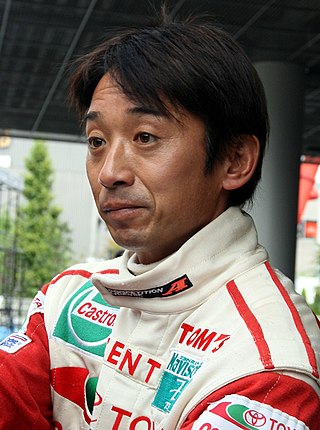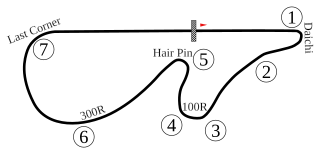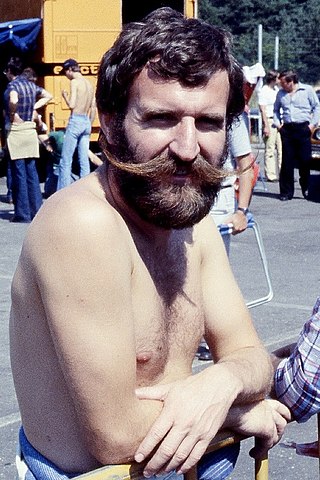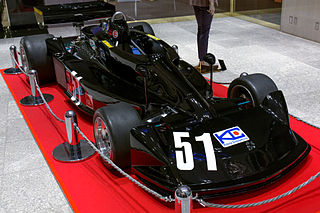
Ukyo Katayama is a Japanese former racing driver and team manager, most notable for competing for six years in Formula One. He participated in 97 Grands Prix, debuting on 1 March 1992. He scored a total of five championship points, all of them for the Tyrrell team in 1994. He also competed in the 1999 24 Hours of Le Mans, finishing 2nd overall and 1st in the GTP class. He currently serves as a team representative for the Japanese continental cycling team JCL Team UKYO and has done so since 2012.
The Super Formula Championship is a formula racing series held primarily in Japan. It is considered to be the pinnacle of single-seater racing in Japan or Asia as a whole, making it one of the top motorsport series in the region. The series is sanctioned by the Japan Automobile Federation (JAF) and managed by Japan Race Promotion (JRP). As of 2024, Super Formula is the second fastest racing series in the world, after Formula One.

The 1976 Japanese Grand Prix1 was a Formula One motor race held at Fuji Speedway on 24 October 1976. It was the 16th and final race of the 1976 Formula One World Championship

The 1997 Australian Grand Prix was a Formula One motor race held at the Albert Park Circuit in Melbourne on 9 March 1997. It was the first race of the 1997 Formula One World Championship, and the second Australian Grand Prix to be held in Melbourne.

Arturo Francesco "Art" Merzario is a racing driver from Italy. He participated in 85 Formula One World Championship Grands Prix, debuting at the 1972 British Grand Prix. He scored 11 championship points.

Jean-Pierre Maurice Georges Beltoise was a French Grand Prix motorcycle road racer and Formula One driver who raced for the Matra and BRM teams. He competed in 88 Grands Prix achieving a single victory, at the 1972 Monaco Grand Prix, and a total of eight podium finishes.

Harald Ertl was an Austrian racing driver and motorsport journalist. He was born in Zell am See and attended the same school as Grand Prix drivers Jochen Rindt, Helmut Marko and Niki Lauda.

Henri Jacques William Pescarolo is a former racing driver from France. He competed in the 24 Hours of Le Mans a record 33 times, winning on four occasions, and won a number of other major sports car events including the 24 Hours of Daytona. He also participated in 64 Formula One World Championship Grands Prix, achieving one podium and 12 championship points. Pescarolo also drove in the Dakar Rally in the 1990s, before retiring from racing at the age of 57. In 2000 he set up his eponymous racing team, Pescarolo Sport, which competed in Le Mans until 2013. He wore a distinctive green helmet, and wears a full-face beard that partially covers burns suffered in a crash.

Kazuyoshi Hoshino is a Japanese former racing driver and businessman.
Noritake Takahara is a former racing driver from Japan. He participated in 2 Formula One World Championship Grands Prix, debuting on 24 October 1976. He scored no championship points. Along with his compatriots Masahiro Hasemi and Kazuyoshi Hoshino, he was the first Japanese driver to start a Formula One Grand Prix.

Kojima Engineering was a Japanese Formula One constructor who entered cars in the Japanese Grand Prix in 1976 and 1977.
Rudolf Krause was a racing driver from East Germany.

Masahiro Hasemi is a former racing driver and team owner from Japan. He started racing motocross when he was 15 years old. In 1964 he signed to drive for Nissan. After establishing himself in saloon car and GT races in Japan, he participated in his only Formula One race at the 1976 Japanese Grand Prix for Kojima on 24 October 1976. He qualified 10th after an error which cost him his chance of a pole position and finished 11th, seven laps behind the winner. Contrary to a widely propagated but mistaken result, however, he never set a fastest lap in a Formula One championship race.1 Along with compatriots Noritake Takahara and Kazuyoshi Hoshino, he was the first Japanese driver to start a Formula One Grand Prix.
Gilby Engineering was a British general engineering company and Formula One constructor owned by Syd Greene.
Volker Hermann Weidler is a retired racing driver from Germany, best known for winning the 24 Hours of Le Mans in 1991.

Motoharu Kurosawa, nicknamed "Gan-san", is a retired professional Japanese racing driver. He is the patriarch of a racing family; his three sons, Takuya, Haruki, and Tsubasa, are all racing drivers.

The BRM P207 was a Formula One racing car, designed by Len Terry and constructed by British Racing Motors, which raced in the 1977 Formula One season. It was powered by a 3.0-litre V12 engine, with a claimed output of 488bhp. London-based Swiss watchmakers Rotary Watches provided sponsorship money. The car failed to score any points during the season. The team made a total of nine entries during the season, but only qualified in one instance, at the 1977 Brazilian Grand Prix. Driven by Larry Perkins, the car retired on lap one due to overheating. Its qualifying time was six seconds slower than that of the second-to-last starter. One British journalist in Brazil exclaimed that he was ashamed of being British. The car failed to appear at the season opening Argentine Grand Prix because it was too wide to fit in the hold of the aircraft that was going to transport it to South America.

There has been a total of 21 Formula One drivers from Japan, of whom 18 took part in a race, with varying degrees of success.
Tetsu Ikuzawa is a Japanese former racing driver, team executive, and businessman from Tokyo, Japan. He is one of the most successful and prolific Japanese drivers from the early years of the nation's automobile racing history. Ikuzawa was the first Japanese driver to regularly compete in a number of notable European championships, namely the British Formula Three Championship and European Formula Two Championship. He was also one of the first Japanese drivers to compete in the 24 Hours of Le Mans endurance race, making his first start in 1973 for Sigma Automotive alongside his countryman, Hiroshi Fushida. In domestic competition, Ikuzawa won the 1964 and 1967 Japanese Grand Prix sports car races, and the 1977 Fuji Grand Champion Series.
The Mooncraft Shiden 77 was a Group 6 sports prototype racing car introduced by Mooncraft in 1977.











